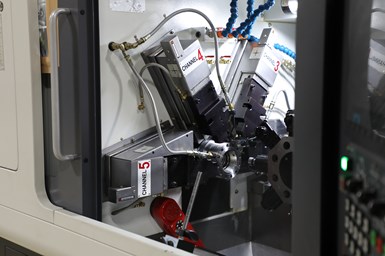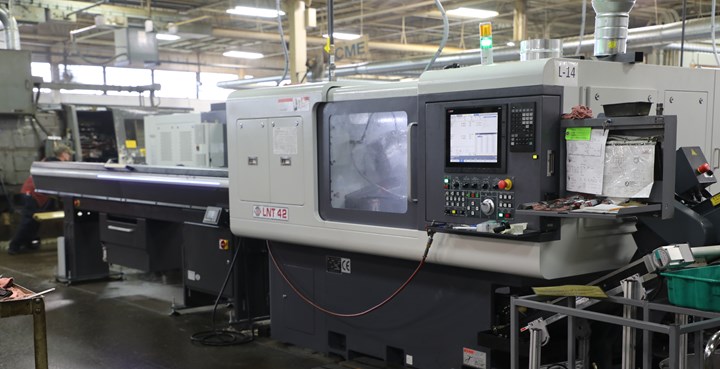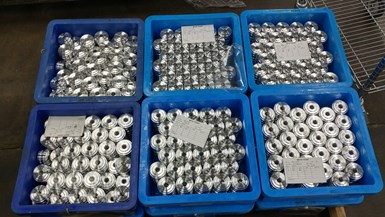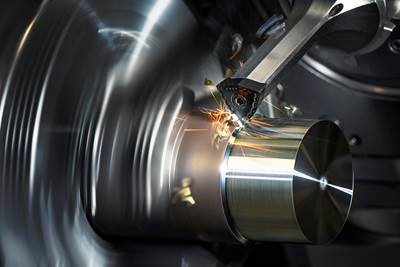
Automatic Products in Sumner, Washington, began as a job shop with cam automatics in the early 1990s. It now has more than 50 CNC machines. The shop began replacing cam automatics with Lico LNTS machines in 2017. Owner Joel Gregory says it was a difficult decision as he had learned the trade on cam automatics, but labor issues forced his hand. The new CNC equipment outperforms the cam automatics by 37%. Plus, for many jobs, the shop runs the machines lights out and has eliminated form tools (and form tool grinding) as well as the need for second-op machines — all with fewer employees. Photo credits: Absolute Machine Tools
In the mid-to-late 1800s, industry’s need for higher machining production led to automating manual turret lathes with cam actuation. Using shafts with revolving drums or flat cams, turret lathes became capable of producing parts with minimal human interaction. Various iterations of these machines then ruled the production turning world for more than 100 years. During that time, there were upgrades to single- and multi-spindle screw machines which increased productivity, capability and safety, while the basic mechanics remained the same — rotating cams were driving mechanical linkage, along with both highly skilled labor and special tools required to set up and operate the machines.
The advent of CNC technology in the 1960s brought the industry large CNC turning centers that, while accurate and versatile, were relatively slow. These progressed throughout the 1970s and eventually became the CNC lathes of today. These machines are now capable of dropping complex parts complete using subspindles, but perhaps haven’t fully addressed the needs of production turning shops running medium- to high-volume batches of parts.
The Swiss-type, sliding headstock lathe industry was the first to apply CNC technology to production turning in the 1970s (CNC single-spindle machines were introduced around that same time). Swiss-types were initially popular in Europe, but it took some time before they became widely adopted in North America. Generally, they are competitively priced, have substantial capability and offer abundant live tooling in a small workzone.
Tooling use is also a unique quality of cam-operated screw machines from the last 100 years. That is, the ability to get multiple tools in the cut simultaneously. While some equipment outside of multi-spindle machines can have only two tools engaged during a cut, new CNC single-spindle machines (such as those offered by Lico and available in the United States from Absolute Machine Tools) can have three engaged simultaneously, thereby boosting productivity and reducing cycle times.
Trending Toward CNC
The primary reasons shops are moving away from cam-actuated machines include equipment age and condition, and a limited available skilled labor force. In addition, customers are calling for tighter tolerances and better finishes, parts are becoming more complex, and lot sizes are becoming smaller. From the machine side, CNC equipment offers lower manpower per part and higher spindle utilization. And, from the regulatory side, CNC machines are much more likely to adhere to OSHA standards than older cam automatics.
The severe shortage of skilled labor for cam-actuated automatics has been the case for many years, but it is now becoming acute. A study performed 10 years ago found that the average age of a setup person for those machines was 55. Today, many of those people are nearing retirement. And, during this time, few companies were training new personnel, often due to the difficulty in locating someone who wanted to pursue this line of work. It takes years to develop a well-trained setup person for cam automatics.

Global Precision Parts has Lico LNTS and LNDD model machines across its three locations. Process Engineer Mike Naticchia has spearheaded their success at short, medium and long-running jobs formerly run on cam automatics and even other CNC platforms. Company President Randy Mueller says the CNC machines have helped reduce labor content per part, while increasing throughput by 200 to 300%.
At the same time, many of the cam automatics have fallen into less-than-prime condition. Spare parts are becoming scarcer and more expensive. Plus, people who possess the knowledge to perform repairs can be rarer than the parts themselves. The cost to refurbish a single-spindle can range from $10,000 to $40,000, while multi-spindles could range from $40,000 to $250,000, depending on repair needs.
Production turning shops, which are seeing tighter tolerance requirements, more features that require secondary operations when run on traditional cam machines, and the need for better finishes are sometimes able to address these situations by using shave tools or burnishing tools. But some of those are limited to straight sections on cam automatics. CNC machines can hold much tighter tolerances, and can turn or bore parts down to 32 micro-inch Ra finishes or better with proper tool selections. Tolerances that would require constant adjustment on cam automatics can be held with minimal human interference on CNC screw machines. In addition, most CNC screw machines have live axial and radial tools, and, when combined with the C axis, can perform milling, cross drilling and tapping, and axial drilling and milling. Some CNC screw machines have B and Y axes available, and can drop even very complex parts complete.
Another common reason for transitioning to CNC is setup time. Single-spindle cam machines can take from 2 to 6 hours to set up; multi-spindle cam machines can take 6 to 16 hours. That means not only is the machine not making a shop money during that time but one of the shop’s most expensive employees is standing in front of the machine that entire time. Conversely, once a job is qualified on a CNC single-spindle machine, setups can often be performed in less than an hour or even faster on repeat jobs.
One more advantage that further helps to reduce cost per part on CNC equipment is the ability to run machines lightly attended or lights out. Magazine bar feeders also enable CNC equipment to attain higher spindle utilization and require greatly reduced manpower to keep the machines stocked with material. Some shops fill the bar feeder magazine and run the machine until that is depleted. Some run their current lot off shift, then start on a new job on first shift. Others can reduce personnel requirements for second or third shifts because the machines run without much attention. This enables them to perform setups on first or second shift and run jobs around the clock.

Northland Screw Products, St. Francis, Minnesota, has moved many jobs off cam-actuated multi-spindles to the LNTS platform. Senior Machinist Alex Martinson has led these efforts, running parts in economical lot sizes with minimal human interface.
Yet another consideration is cleanliness and safety. CNC automatics are fully enclosed, generally with safety interlocks on enclosure doors. This reduces the opportunity for slips and falls by keeping oil and coolant in the machine and off of the floor. They are often easily connected to mist evacuation systems, thereby improving air quality for workers. The effective interlocks between door and PLC on the CNC ensure that employees are free and clear of the cutting area while the machine is running, which reduces opportunities for injuries from operating equipment.
Legacy cam automatics have heavy sliding doors (or no doors), no safety interlocks, and often a multitude of gaps in guarding through which fluids and even chips can exit the machine and create slippery, hazardous shopfloor conditions. The sheer number of possible pinch points on the older cam automatics are also difficult to guard, and fabricating full metal enclosures to protect workers, reduce sound levels while operating and contain fluids have a disadvantage in that they make machine setups more difficult and longer to complete.
Shop Experiences
A number of shops have made the transition from cam-actuated machines to Lico CNC single-spindle equipment for the reasons stated above. For example, Delphos, Ohio’s Vanamatic began running Lico machines in 2008. They have added several over the years, and now run nine LNTS-model machines. They have increased production rates and improved part quality by moving some aerospace part families from eight spindle machines and second-op machines to machining complete on the LNTS models. According to Jared Wiltsie, a Vanamatic engineer, the shop cuts a lot of difficult stainless material and whereas one operator needed to continually tend an 8-spindle machine, one operator can now tend three or more LNTS machines which produce parts complete.

Air-Way Manufacturing in Olivet, Michigan, is a manufacturer and distributor of hydraulic fittings for OEM use. The company currently uses four Lico LNDD machines at two different plants. According to Manufacturing Technology Manager Troy Newman, it uses these machines to offload short- to medium-run parts off cam-actuated multi-spindles, tooling the CNC machines to run some off-shift work.
Similarly, Quality Switch in Newton Falls, Ohio, purchased screw-machined parts from outside vendors while producing some larger-diameter parts on multifunction CNC lathes. Jeremy Sewell, vice president, says the company has saved money running the smaller parts in house on its LNDD machines. Plus, the company machines those parts for its own products, so it is also now in better control in terms of manufacturing scheduling.
Photos throughout this story highlight other examples. Some shops were ahead of the adoption curve, while others have moved on from the cam machines due to necessity. Pinched labor resources, tighter tolerances and finishes, shorter setup times, and a safer work environment are powerful motivators to make the move into CNC production turning. Shops have also found that modern CNC screw machines are big contributors to their financial success.
Related Content
5-Axis Machining Centers Transform Medical Swiss Shop
Traditionally a Swiss machine shop, Swiss Precision Machining Inc. discovers a five-axis machining center that has led the company to substantial growth. (Includes video.)
Read MoreDoes a Scanning Probe Make Sense on a Swiss-Type?
Swiss-types have limited tooling capacity, but there can be advantages to giving up some of that capacity to take advantage of a touch probe — in fact, a scanning probe — to enable in-process part measurements.
Read MorePursuit of Parts Collector Spearheads New Enterprise
While searching for a small parts accumulator for Swiss-type lathes, this machine shop CEO not only found what he was looking for but also discovered how to become a distributor for the unique product.
Read MoreWhen a CNC Turn-Mill Doesn’t Turn
A shop in Big Sky Country uses a B-axis multitasking machine to produce complex, prismatic medical parts that require no turning complete from barstock.
Read MoreRead Next
A New Approach to CNC Turning
This turning process takes advantage of a turn-mill’s B-axis spindle to vary a tool’s approach angle to optimize chip control and feed rates.
Read MoreWhy a CNC Multi-Spindle Machining Center Makes Sense for MetalQuest
An early adopter of multitasking equipment, this Nebraska contract manufacturer has taken what it feels is the next logical step to diversify by adding a multi-spindle for greatly reduced cycle times on an existing high-volume job.
Read MoreSpeed, Process Control Combine in Refreshened Multi-Spindle Platform
A screw machine design known for its high production speed — but also its finicky nature to set up and run — has evolved to provide computer control, better accuracy and improved repeatability.
Read More







.jpg;maxWidth=300;quality=90)














